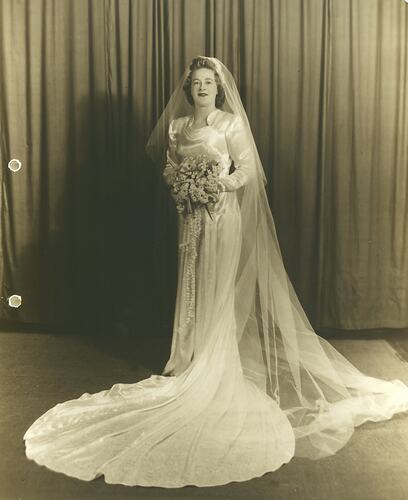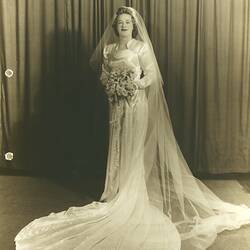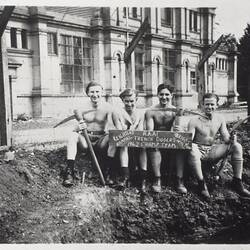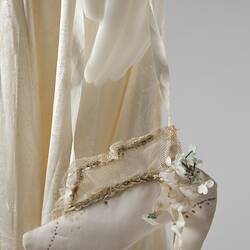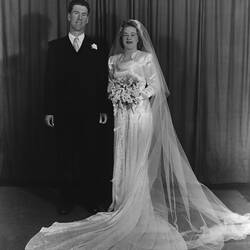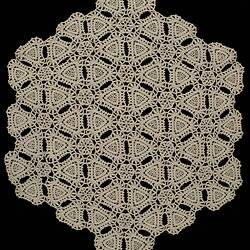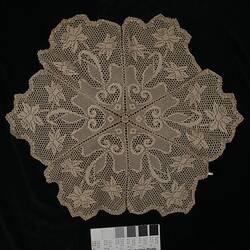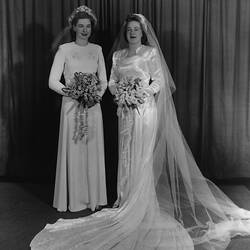Elaine Heather Colbert, nee Smith, was born in 1926, and attended MacRobertson Girls' High School with her older sister Mina. Her mother was president of the mother's club. She wanted to be a nurse, but her father did not allow her that choice. Instead, as she was good at drawing she studied architectural drafting at night at Melbourne Technical College (a three-year course would give university entry to become an architect). Elaine worked during the day as a draftsperson at the Public Works Department, paying her own way through college, conscious that her father had already struggled to put her brother and sister through university. She didn't quite finish the three-year course, instead getting married.
As a young woman during the war and early post-war years, Elaine acted as a hostess at local dances for servicemen. She invited them home to enjoy her family's hospitality - their home was conveniently near Gardenvale Station. One day in late 1946 she invited an RAAF Aircraftman, Leo Thomas Colbert ('Dick'), service no. 439086. Dick was a then 24-year-old from a farm in the Kyabram area, training to be a radio operator. He asked if he could bring his friend Ken, and offered to drive Elaine and her sister Mina back to their home in his ute. Everyone got on well (Dick charmed Elaine's family), and the men invited Elaine and Mina to the cricket the next day - the first test match since the War, with England playing Australia. Before long Mina was engaged to Ken. They married in April 1947. Elaine and Dick decided to marry on 6 September, with Mina as a bridesmaid.
Dick's war experience had only just ended - he had been discharged on 6 June 1946. He had enlisted in the RAAF, Air Crew V, on 14 January 1944, aged 21-year-old and working as a farmer/orchardist in the Kyabram area. He was remustered to 'Training Tech' on 25 February and was posted to 1 S.T.T. (then located in the Exhibition Building, Melbourne) on 3 March, where he undertook a Fitters Course, which he passed, and a wireless maintenance mechanics course, which he failed. He remained at 1 S.T.T. until 29 May 1944. He was then posted to various sites around Australia, but not north of parallel 14.5 or beyond Australia. He returned to 1 S.T.T. on 10 February 1945, after a long period (perhaps four months) in hospital with serious illness, and remained there until May. In June 1944 he undertook clerical training, and ended the war on clerical pay, ranked as an Aircraftman 1. His address after the war was Shepparton.
Having decided to get married, Elaine set to work and designed her wedding dress - donated to Museum Victoria. She had designed many dresses in the past, and generally made her own. (During the War, she often used curtain fabrics due to rationing.) This time she asked her mother's dressmaker to make the dress (Miss ?), with fabric Elaine bought with clothing coupons from Georges. She was pleased at the way the dropped waist and fitted shoulders flattered her shape. Years later, a neighbour remembered how beautiful the dress was. Elaine wore it with a full-length veil, which she later sent to England, to the sister of a naval officer who had once showed her around a midget sub (post-war shortages were problematic in England).
Elaine bought a going away outfit from Georges with further coupons: a mid-blue skirt, just below the knee, with two front pleats (one on each side) and a single black pleat, and matching jacket.
Elaine and Dick married on 6 September 1947 at the Presbyterian Church on the corner of New Street and North Road (still extant. The church was designed by Charles Webb and opened 1876; it later became a Uniting Church. It is now in private hands). The organ was played by Mr Windrum, who Elaine remembers as a 'lovely man'. A local professional photographer took photographs, printed in the local paper. (The name of the photographer of the wedding picture donated to the Museum is unknown.) Elaine carried white/pink hyacinths grown by her mother, a keen gardener; her sister Mina carried pink hyacinths. The reception was held around the corner from the church, in the church hall. It was catered: everyone wanted to create a happy event and 'do things because of the war', remembered Elaine; 'all the neighbourhood came'. Wedding presents included a 12" vase (that Elaine still has), Pyrex dish, cake dish, silver dish (silver just available again after the war), sandwich tray, two breakfast sets (each two cups and saucers with plates, and a milk jug), and a 'beautiful' English china teapot from a friend that Elaine still uses for special occasions.
The couple stayed at the Federal Hotel in the city on their wedding night (at 555 Collins Street; demolished in 1973). The next morning they set out by train for Mallacoota, an all-day journey. They took two trains and a bus, finally arriving at midnight, exhausted. Their hotel reception was closed, but the bus driver had a key to their room. During the following days they went boating with other honeymooning couples, played golf and went for walks.
After their honeymoon, Elaine and Dick moved in with Elaine's parents for a short while. Then Dick got an ex-serviceman's government grant to buy a one-acre poultry farm in Clayton. Dick was from a rural background, but his father had sold the family farm during the war years - three older brothers had all joined the services, as well as Dick.
Dick and Elaine's farm had an old four-roomed house, with a tiny bathroom with basin and a lean-to. The lean-to contained a spare bed (where Elaine's father sometimes stayed), a kitchen, a toilet, and a place to clean eggs. Elaine particularly enjoyed the fact that the house had hot running water, which her parents did not have. The house was furnished with some 'beautiful' cedar pieces inherited from her great aunt, which remain in the family to this day.
The farm had about 500 fowls, and Elaine chopped corn and hay for them. Dick worked for about six months in a government job to save money for poultry sheds, which he built with his father-in-law (Dick had beautiful handwriting so found work easily, in spite of his 8th grade education). The farm had permanent water at the back of the block.
Dick and Elaine stayed on the farm for three years, but dust got into Dick's eyes and he developed eye trouble. They decided to leave the farm and move to Tyabb, on the Mornington Peninsula, where they ran the general store. They had two young sons by then, and a third was born soon afterwards. It was too much work, and after 12 months they moved to Mornington. Dick found employment as an Egg Board inspector, and stayed with the Egg Board for the rest of his professional life. His work took him around Victoria for periods of a week at a time, driving the family car. He loved being in the country.
Thinking back over her married life, Elaine says that there were 'certain borders that I couldn't get outside' - and neither did her husband. She had clear routines that she followed, and believed in openness in the family. No drink was allowed in the house, they never swore (Dick's family also never swore), they respected each other, and provided love and support.
Elaine donated her wedding dress, accessories, photographs and home accounting books to Museums Victoria in 2008. She passed away in 2015.
References:
Information provided by Elaine Colbert to Deborah Tout-Smith in several conversations during 2009-2010.
Service record Leo Thomas Colbert, National Archives of Australia, barcode 5551226.
More Information
-
Keywords
-
Localities
-
Authors
-
Article types
